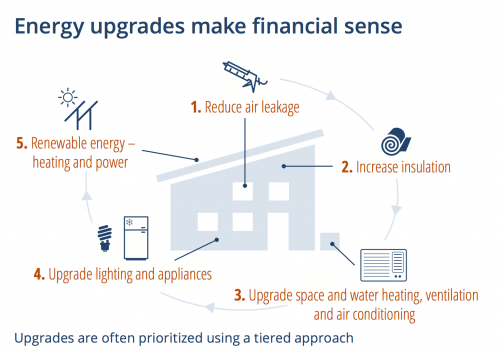
The Balfour Seniors' Centre benefitted from energy efficiency retrofits.
Advancing energy efficiency in buildings is a pillar of our country’s greenhouse gas emissions reduction strategy and key for Canada to meet its commitments under the Paris Agreement. One segment of the building stock is that owned by the non-profit community — churches, community halls, low-income housing etc. The non-profit sector faces challenges such as utility bills, aging buildings and limited cash flow. That makes it hard for groups to agree where a surplus operating budget would best be spent let alone get ahead on improving the efficiency of their buildings.
However, with strategic thinking, government funds, patience and community champions, it is possible to roll up one’s sleeves, obtain grant money and make progress on improving the state of these buildings.
Case study
The Pembina Institute not only works on advancing clean energy policy, it also does “on-the-ground” work to realize clean energy solutions. Over the past year, we have worked with several non-profit societies in the West Kootenay area to understand what energy efficiency upgrades will be valuable to them, what those might cost and where to get grant money to complete upgrades. The recipe is as follows:
- Find a local champion that sees the value in supporting these non-profit societies. In our example, we engaged with Area E Director in the Regional District of the Central Kootenays.
- Access funding to perform an energy analysis modelling exercise to get a real appreciation for how energy is consumed in the building. We obtained funding from the RDCK’s Community Development Grant, hired a local Registered Energy Advisor and presented a list of prioritized energy efficiency upgrades that made sense for a particular building.
- Work with the society to sort through options and choose the best projects to move forward with.
- Access further funding to support the capital investment required to perform the upgrades. In our example, the non-profit society applied for grants from RDCK’s Community Works Fund — which is funding from the Federal Gas Tax Fund that is made available to municipalities.
- Hire local trades, get the work done and evaluate the energy savings months after the upgrades are completed.
 The Balfour Seniors’ Association is one of three community groups the Pembina Institute worked with through this process. They received grants to perform upgrades on their seniors’ hall, a single-story 1,200 square feet building. They added exterior insulation and siding, put in EnergyStar windows and doors, switched from electric baseboard heaters to air-source ductless heat pumps and upgraded all of the lighting from incandescent to LED lighting. A post evaluation of their utility bills after all the upgrades show a 40–50 per cent energy savings and utility bill savings of about $400 per year. Local trade HVAC, insulation, windows and door companies were hired to complete the work. With energy efficiency improvements complete, the society is now looking towards implementing solar photovoltaics on its roof to generate electricity and connect through its utility’s net metering program.
The Balfour Seniors’ Association is one of three community groups the Pembina Institute worked with through this process. They received grants to perform upgrades on their seniors’ hall, a single-story 1,200 square feet building. They added exterior insulation and siding, put in EnergyStar windows and doors, switched from electric baseboard heaters to air-source ductless heat pumps and upgraded all of the lighting from incandescent to LED lighting. A post evaluation of their utility bills after all the upgrades show a 40–50 per cent energy savings and utility bill savings of about $400 per year. Local trade HVAC, insulation, windows and door companies were hired to complete the work. With energy efficiency improvements complete, the society is now looking towards implementing solar photovoltaics on its roof to generate electricity and connect through its utility’s net metering program.
“Our membership has grown to over 50 members from 10 to 15 because the hall is now a welcome place — bright and comfortable and accommodating. We get nothing but praise from those who use the hall. The hall is now in use 4 days a week, from September to June. We are exceedingly happy with the outcome.”
Success factors
Advancing energy efficiency for the non-profit sector was successful because of the accessibility of grants as opposed to loans or rebates. Such grants are only possible through effective policies and government leadership on climate change by using government money raised through gas and carbon taxes to incent further greenhouse gas reductions.
What can we apply going forward?
 Effective energy efficiency policies are needed for all building types because of the large percentage of GHG emissions our building stock represents. Policies must be fully encompassing and not target only a small portion of that stock. In Alberta, the government Climate Leadership Plan is set to contribute $645 million to energy efficiency. This is an opportunity for the government to design and implement a program that takes into account all sectors and maximize the outcomes based on dollars invested. Investing in energy efficiency will have a multiplier effect, creating jobs by fostering new businesses and supporting existing ones. A report from the Acadia Centre shows that every $1 invested in energy efficiency results in a GDP increase of $5 to $8, and every $1 million invested in energy efficiency programs generates 30 to 52 job-years.
Effective energy efficiency policies are needed for all building types because of the large percentage of GHG emissions our building stock represents. Policies must be fully encompassing and not target only a small portion of that stock. In Alberta, the government Climate Leadership Plan is set to contribute $645 million to energy efficiency. This is an opportunity for the government to design and implement a program that takes into account all sectors and maximize the outcomes based on dollars invested. Investing in energy efficiency will have a multiplier effect, creating jobs by fostering new businesses and supporting existing ones. A report from the Acadia Centre shows that every $1 invested in energy efficiency results in a GDP increase of $5 to $8, and every $1 million invested in energy efficiency programs generates 30 to 52 job-years.
The Pembina Institute continues to advance effective energy efficiency policy by providing valuable input into Alberta’s Climate Leadership Plan. We are also holding a workshop on August 31st focused on designing an effective EE program for the non-profit sector. If you are interested, please sign up here.
Read the Balfour Seniors’ Hall and Procter Old Schoolhouse Energy Efficiency case studies.
Want to learn more about the opportunities in energy efficiency for non-profits in Alberta? Come to the Pembina Institute’s Alberta Climate Summit 2016, where we’ll bring experts from across North America to share their lessons and keys to success.
Dave Lovekin is an advisor to the Pembina Institute's renewables in remote communities program; he was director of the program until 2023.



